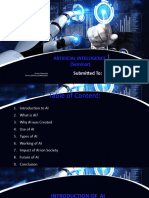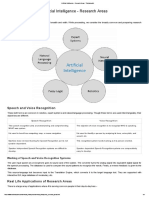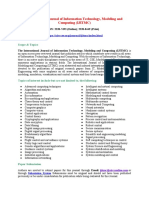Introduction to Artificial Intelligence
1. What is Artificial Intelligence?
Artificial Intelligence (AI) is the branch of computer science that creates machines capable of
performing tasks requiring human intelligence such as reasoning, learning, and problem-solving. It
is widely applied in areas like self-driving cars, healthcare, voice assistants, and recommendation
systems. AI is the ability of a machine to simulate intelligent human behavior. John McCarthy
(1956) defined AI as "the science and engineering of making intelligent machines, especially
intelligent computer programs."
2. Foundations of AI
AI is built on several disciplines: - Mathematics: Provides algorithms, logic, and probability. -
Computer Science: Supplies programming languages and hardware. - Psychology: Helps in
modeling human behavior and cognition. - Biology and Neuroscience: Inspired neural networks
from the human brain. - Economics: Contributes to rational decision-making and optimization.
3. History of AI
The journey of AI began in the 1940s–50s when Alan Turing proposed the Turing Test. In 1956, the
Dartmouth Conference officially introduced AI as a field. The 1960s and 70s saw theorem-proving
programs and robots. In the 1980s, expert systems like MYCIN emerged. The 1990s–2000s were
marked by machine learning, with IBM's Deep Blue defeating chess champion Garry Kasparov in
1997. The 2010s brought deep learning, modern robotics, and applications like self-driving cars,
chatbots, and advanced healthcare AI.
4. Intelligent Agents
An intelligent agent perceives its environment through sensors and acts using actuators. For
example, a robot vacuum cleaner uses sensors (dust detectors, cameras) and actuators (wheels,
brushes) to clean effectively. Thus, an agent can be defined as Sensors + Actuators +
Decision-making ability.
5. Environments of Agents
The environment is the world in which an agent operates. Types include: - Fully Observable vs.
Partially Observable: Chess is fully observable, driving in fog is partially observable. - Deterministic
vs. Stochastic: Tic-tac-toe is deterministic, the stock market is stochastic. - Static vs. Dynamic: A
crossword puzzle is static, road traffic is dynamic. - Discrete vs. Continuous: Chess is discrete,
driving a car is continuous.
6. Concept of Rationality
A rational agent always chooses the best action to maximize performance. For example, a
self-driving car selects the safest route, while a chess AI chooses the move that increases its
winning chance.
7. Structure of Agents
Agents can be classified as: - Simple Reflex Agents: Work on condition-action rules. Example:
Thermostat. - Model-Based Reflex Agents: Use memory of past actions. Example: Robot vacuum
mapping rooms. - Goal-Based Agents: Act to achieve specific goals. Example: GPS navigation
systems. - Utility-Based Agents: Maximize satisfaction beyond goals. Example: Recommendation
systems.
�8. Importance of AI
AI plays a vital role in modern society: - Education: Virtual tutors and smart learning. - Healthcare:
Diagnosis, prediction, robotic surgery. - Transportation: Self-driving cars, traffic analysis. -
Entertainment: Games, VR/AR, personalized recommendations. - Business: Fraud detection,
chatbots, analytics.
9. Conclusion
Artificial Intelligence has grown from a theoretical concept into one of the most transformative
technologies of our era. It combines knowledge from mathematics, computer science, psychology,
biology, and economics to design systems that can reason, learn, and adapt. Understanding
intelligent agents, environments, rationality, and agent structures forms the core of AI. From simple
reflex machines to utility-based systems, AI has become integral to daily life. Future advancements
promise even deeper integration, making human life easier, safer, and more efficient.





















































































